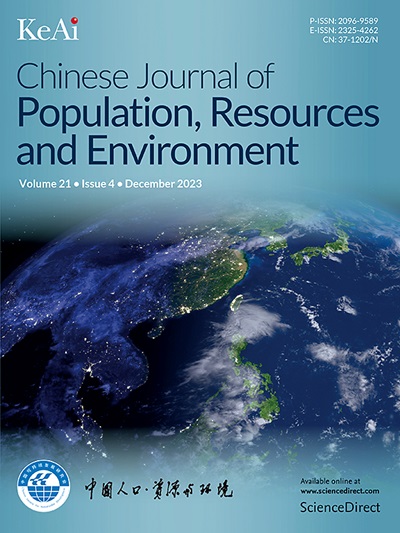城市群碳减排能力空间网络特征及驱动因素——以山东省为例
IF 4.8
4区 环境科学与生态学
Q2 ENVIRONMENTAL STUDIES
Chinese Journal of Population Resources and Environment
Pub Date : 2024-12-01
DOI:10.1016/j.cjpre.2024.11.002
引用次数: 0
摘要
城市规模协同碳减排是中国实现碳减排承诺、促进区域可持续协同发展的内在要求。本文以山东省16个地级市为例,基于碳减排、环境保护和经济增长目标的协同发展,对区域碳减排能力(CERC)进行了定义和量化。采用社会网络分析和二次分配过程回归分析方法,分析了中国中部城市群及其驱动因素的空间网络特征。结果表明:地级市间CERC的空间相关性呈上升趋势;济南-淄博-青岛是网络的中心,而鲁西南和鲁东北的空间联系强度较弱。地理空间距离和科学发展水平差异对空间关联强度有显著的负向影响,而经济和信息化发展水平差异对空间关联强度有显著的正向影响。环境监管差异和运输差异不显著。本研究为其他国家或地区的类似研究提供了方法上的借鉴。同时,研究结果为政府合理配置城市资源,促进区域协同碳减排提供了科学依据。本文章由计算机程序翻译,如有差异,请以英文原文为准。
Spatial network characteristics and drivers of carbon emission reduction capability in urban agglomerations: A case study of Shandong Province
Synergistic carbon emission reduction at the urban scale is an inherent requirement for China to realize its carbon emission reduction commitments and promote sustainable and regional synergistic development. Using 16 prefectural cities in Shandong Province as an example, this study defines and quantifies the regional carbon emission reduction capacity (CERC) based on the synergistic development of carbon emission reduction, environmental protection, and economic growth objectives. The spatial network characteristics of the (CERC) and its drivers were analyzed using social network analysis and quadratic assignment procedure regression methods. The results revealed that the spatial correlation of the CERC among prefectural cities has been increasing over the years. Jinan-Zibo-Qingdao is the center of the network, while the spatial linkage strength in the southwest and northeast of Shandong Province is weak. Geospatial distance and scientific development differences have a significant negative effect on the intensity of spatial association, while differences in economic and informatization developments have a considerable positive impact. Environmental regulatory differences and transportation differences are not significant. This study offers a methodological reference for similar studies in other countries or regions. At the same time, the findings provide a scientific basis for the government to rationally allocate urban resources and promote regional synergistic carbon emission reduction.
求助全文
通过发布文献求助,成功后即可免费获取论文全文。
去求助
来源期刊

Chinese Journal of Population Resources and Environment
ENVIRONMENTAL STUDIES-
CiteScore
4.30
自引率
1.10%
发文量
791
审稿时长
79 days
期刊介绍:
The Chinese Journal of Population, Resources and Environment (CJPRE) is a peer-reviewed international academic journal that publishes original research in the fields of economic, population, resource, and environment studies as they relate to sustainable development. The journal aims to address and evaluate theoretical frameworks, capability building initiatives, strategic goals, ethical values, empirical research, methodologies, and techniques in the field. CJPRE began publication in 1992 and is sponsored by the Chinese Society for Sustainable Development (CSSD), the Research Center for Sustainable Development of Shandong Province, the Administrative Center for China's Agenda 21 (ACCA21), and Shandong Normal University. The Chinese title of the journal was inscribed by the former Chinese leader, Mr. Deng Xiaoping. Initially focused on China's advances in sustainable development, CJPRE now also highlights global developments from both developed and developing countries.
 求助内容:
求助内容: 应助结果提醒方式:
应助结果提醒方式:


